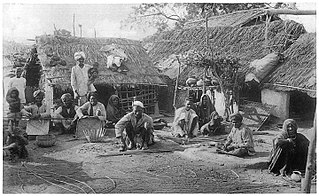This page is based on this
Wikipedia article Text is available under the
CC BY-SA 4.0 license; additional terms may apply.
Images, videos and audio are available under their respective licenses.
Kamma is a caste from South India. They sometimes append the caste title Naidu to call themselves Kamma Naidu. They are classified as a forward caste.
Mala are Dalits from the south Indian states of Andhra Pradesh, Telangana and Karnataka. Mala groups are considered as Scheduled Castes by the Government of India.
The Valmiki is a large cluster of castes, and local groups from the Indian subcontinent. The Valmikis can be classified as a caste or Sampradaya (tradition). In terms of being classified as Sampradaya, the Valmikis trace their tradition to the Hindu sage Valmiki who is traditionally ascribed as the writer of the epic Ramayana.
Reddy is a caste that originated in India, predominantly settled in Andhra Pradesh and Telangana. They are classified as a forward caste.

The Musunuri Nayakas were warrior kings of 14th-century South India who were briefly significant in the region of present-day Andhra Pradesh and Telangana.
The Raju are a Telugu caste found mostly in the Indian state of Andhra Pradesh.
Velama is a caste found mainly in Andhra Pradesh and Telangana. The earliest occurrence of Velama as a term for a community dates from the 17th century.
Kapu refers to a social grouping of agriculturists found primarily in the southern Indian state of Andhra Pradesh. Kapus are primarily an agrarian community, forming a heterogeneous peasant caste.
The system of reservation in India consists of a series of measures, such as reserving access to seats in the various legislatures, to government jobs, and to enrollment in higher educational institutions. The reservation nourishes the historically disadvantaged castes and tribes, listed as Scheduled Castes and Scheduled tribes by the Government of India, also those designated as Non-Creamy layer Other Backwards Classes (OBCs) and also the economically backward general. The reservation is undertaken to address the historic oppression, inequality, and discrimination faced by those communities and to give these communities a place. It is intended to realise the promise of equality enshrined in the Constitution.
Balija is a caste of the Indian states of Andhra Pradesh, Tamil Nadu, Karnataka, and Kerala.
Telaga is a community of agriculturists (Kapus) in the Coastal Andhra Pradesh, concentrated in the West and East Godavari districts. They are also found in smaller numbers in Visakhapatnam and Srikakulam districts. Telaga is regarded as a subcaste of Kapu.
Padmashali is a Telugu-speaking Hindu caste residing in the Indian states of Andhra Pradesh, Karnataka, Maharashtra, Gujarat and Tamil Nadu.
The 'Boyar is a Caste commonly found in Tamil Nadu, Karnataka and Andhra Pradesh India.
Rajam Assembly constituency is a SC reserved constituency of the Andhra Pradesh Legislative Assembly, India. It is one of 10 constituencies in the Srikakulam district.
Pamarru Assembly constituency is a SC reserved constituency of the Andhra Pradesh Legislative Assembly, India. It is one of 16 constituencies in the Krishna district.
Prathipadu Assembly constituency is a SC reserved constituency of the Andhra Pradesh Legislative Assembly, India. It is one of 17 constituencies in the Guntur district.
Yerragondapalem Assembly constituency is a SC reserved constituency of Andhra Pradesh Legislative Assembly, India. It is one of 12 constituencies in the Prakasam district.
Gandhara Nellore Assembly constituency is a SC reserved constituency of Andhra Pradesh Legislative Assembly, India. It is one among 14 constituencies in Chittoor district.

The Komati is an Indian trading community found primarily in South and Central India, that is currently organised as a caste. The members of the Komati caste are commonly engaged in banking, money lending and other business pursuits. The community consists of three sects who are followers of Hinduism, namely the Gaura or Gavara, the Thrivarnika and the Kalinga, along with the Jaina Komatis who are followers of Jainism.






